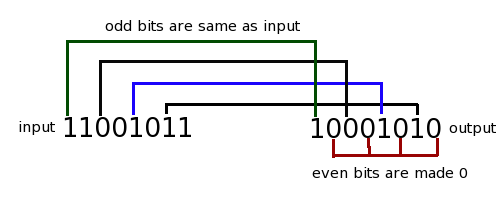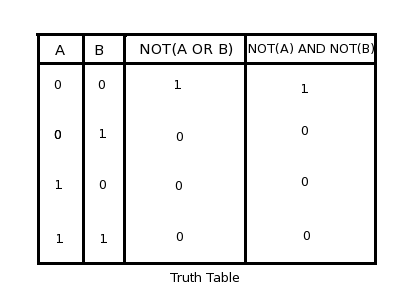|
|
|||||||||||||||||||||||||||||||||||||||||||||||||||||||||||||||||||||||||||||||
Homework 2 // Due at lecture Friday Feb 8
Primary contact for this homework: Priyananda Shenoy [shenoy at cs.wisc.edu] |
|||||||||||||||||||||||||||||||||||||||||||||||||||||||||||||||||||||||||||||||
| 01001101 | |
| + | 00000001 |
| 01001110 | |
Problem 3
The range of a representation is the set of values which can be represented using that representation. For example, if an integer is represented by 5 unsigned bits, then its range is 0 to 31. What is the range of an integer represented in 8-bit 2's complement form?
-28-1 to +(28-1 - 1) = -128 to +127
Problem 4
Let X = 101010, Y = 110011 and Z = 011101. Then evaluate the following:
a) (X OR Y) AND Z
| X | 101010 |
| Y | 110011
|
| X OR Y | 111011
|
| Z | 011101
|
| (X OR Y) AND Z | 011001
|
| Y | 110011 |
| Z | 011101
|
| Y AND Z | 010001
|
| X | 101010
|
| X OR (Y AND Z) | 111011
|
| X | 101010 |
| Y | 110011
|
| X OR Y | 111011
|
| X | 101010 |
| Z | 011101
|
| X OR Z | 111111
|
| (X OR Y) AND (X OR Z) | 111011 |
Problem 5
Convert the following bit sequence into hexadecimal
1111101011001110000011111111
- starting from the left, split the number into groups of 4 bits.
1111 1010 1100 1110 0000 1111 1111
- For each group of 4 bits, use the conversion table to find the hexadecimal value.
1111 = 0xF, 1010 = 0xA, 1100 = 0xC, 1110 = 0xE, 0000 = 0x0
The given value in hex is 0xFACE0FF.
Problem 6
Write the decimal equivalents for these IEEE floating point numbers.
a) 0 01010111 00000000000000000000000
The sign bit is '0', so it is a positive number. Since the exponent is greater than 0, the formula to be used is:
value = (-1)s * 1.F * 2E-127
Here F = 0, and the exponent E = 010101112 = 8710
value = (-1)0 * 1.0 * 287-127 = 2-40 = 9.095 * 10-13
b) 1 01111010 10000000000000000000000
The sign bit is '1', so it is a negetive number. Since the exponent is greater than 0, the formula to be used is:
value = (-1)s * 1.F * 2E-127
Here F = 0.12 = 0.510, and the exponent E = 011110102 = 12210
value = (-1)1 * 1.5 * 2122-127 = -3/64 = -0.046875
Problem 7
Translate the following ASCII codes into a string of characters by interpreting each group of eight bits as an ASCII character:
0x5448495320495320535041525441
(0x20 is the 'space' character)
THIS IS SPARTA
(No extra points for Leonidas jokes!)
Problem 8
Consider an operation CLEAR-EVEN-BITS which takes in an input bit sequence and gives as output the following sequence:
a) all even bits of the output(0th bit, 2nd bit etc) are set to 0
b) all odd bits of the output are the same as the corresponding input bits.
For example, if input is 11001011, then output is 10001010. See image below for clarifications

Implement this operation using any of NOT,AND,OR. Assume that the input is always 8-bits long. The 0th bit is the right most bit.
(hint:Your answer should be output = {an expression with AND,OR,NOT which uses input}
We can arrive at the answer by noticing the following properties about the AND operator:
- X AND 0 = 0, irrespective of what value X takes
- X AND 1 = X
CLEAR-EVEN-BITS(X) = X AND 10101010
Problem 9
The following binary numbers are 4-bit 2's complement binary numbers. Which of the following operations generate overflow? Justify your answers by translating the operands and results into decimal.
a) 0111 + 1001
| 0111 | +710 | |
| + | 1001 | -710 |
| 0000 | 010 |
b) 1000 - 0001
| 1000 | -810 | |
| - | 0001 | +110 |
| 0111 | 710 |
c) 0111 + 0001
| 0111 | +710 | |
| + | 0001 | +110 |
| 1000 | -810 |
d) 1110 + 1000
| 1110 | -210 | |
| + | 1000 | -810 |
| 0110 | +610 |
Problem 10
a)Show that the following expressions are equivalent
NOT(A OR B) = NOT(A) AND NOT(B)
(hint:write truth tables for both, and show that they have same values in all rows)

b) Using the property (a), implement the OR operation using AND and NOT operators only.
(hint: NOT(NOT(A)) = A )
A OR B = NOT( NOT(A) AND NOT(B) )
